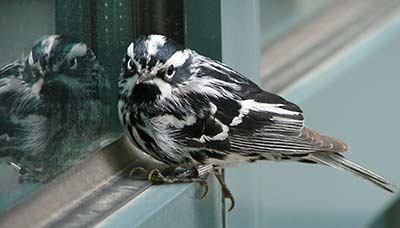Should Green Buildings Have Green Windows?
By Daniel Klem, Jr.
October 15, 2009

Windows need to be more than energy efficient
Except for habitat destruction, collisions with windows kill more birds than any other human-associated direct cause. It is likely that one billion birds are killed colliding with windows in the United States every year. A study published in 2009 in The Wilson Journal of Ornithology systematically monitored an urban area in New York City, concluding that 34 million birds are killed at windows in urban areas alone in North America north of Mexico every year. And the problem is ever growing. New construction uses 40 billion square feet of sheet glass annually worldwide.
Because of concerns about energy costs, climate change, and other pressing issues, glass manufacturers are constantly creating new kinds of glass and window designs to conserve energy. But despite the clear and present danger that windows pose to birds, there are no compelling forces driving the development of bird-safe glass and window designs. Relatively few architects promote bird-safe windows for new and remodeled construction. Among those that do are Jeanne Gang and Mark Schendel of Studio Gang Architects in Chicago, who produced an award-winning design for the City of Chicago’s Ford Calumet Environmental Center, and Hillary Brown of NewCivicWorks in New York, who co-authored the booklet Bird-Safe Building Guidelines describing environmentally responsible construction. But unless there are more incentives for creating bird-safe windows, the problem will continue to grow.


One way we could provide real incentives for the development of bird-safe glass would be to make bird safety a factor in defining environmentally responsible construction. Government guidelines require new and renovated construction on any of the 500,000 federal buildings in the United States to minimally meet the U.S. Green Building Council’s Silver certification level of the Leadership in Energy and Environmental Design (LEED) Green Building Rating System. Federal concerns in the LEED criteria include issues regarding the construction site, minimizing non-renewable energy consumption, use of environmentally preferred products, water conservation and protection, indoor environmental quality, and optimizing operational and maintenance practices. But the LEED evaluation lacks a requirement to ensure that windows are bird-safe.
A recent study reported on a new exterior film using ultraviolet signals that is especially promising for retrofitting existing windows, and the use of these same signals as coating on sheet glass for new construction is a hopeful long-term solution for preventing bird-window collisions. Neither the film nor the glass is currently available, but increased interest by architects and informed citizens would convince manufacturers that investment in these products is worthy and justifiable. After all, how can a green building be truly “green” when it kills birds?
Daniel Klem, Sarkis Acopian Professor of Ornithology & Conservation Biology at Muhlenberg College, has been researching bird-window collisions since 1974.
Originally published in the October 2009 issue of BirdScope.


All About Birds is a free resource
Available for everyone,
funded by donors like you




